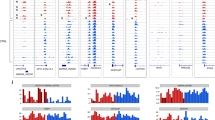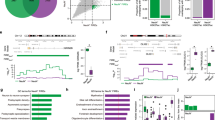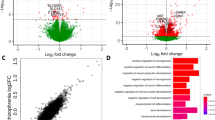Abstract
Heterochromatin is a higher order assembly that is characterized by a genome-wide distribution, gene-repression, durability and potential to spread. In this light, it is an appealing mechanism to interpret the neurobiology of complex brain disorders such as schizophrenia where downregulation of expression appears to be the norm. H3K9 methylation (H3K9me) can initiate the seeding of a heterochromatin assembly on an inactive or poorly coordinated promoter as a consequence of a decline in transactivators either from disuse or from misuse. H3K9me can extend its influence by spatial spreading through the mechanism of recursively recruiting adapters, such as heterochromatin protein 1 (HP1) homodimers. HP1 itself serves as a platform for other repressive proteins such as DNA methyltransferases. In full color, heterochromatin can occupy genome-wide gene networks, tissue specific ontologies and even rearrange the nuclear architecture. Heterochromatin in the brain is modified by small molecule pharmacology and serves a physiological role in the functioning of dopamine neurons and the construction of memory. From a therapeutic perspective, the durable nature of heterochromatin implies that it may require disassembly before the full genomic-potential of standard pharmacotherapies is achieved, especially in treatment resistant patients.
This is a preview of subscription content, access via your institution
Access options
Subscribe to this journal
Receive 6 print issues and online access
$259.00 per year
only $43.17 per issue
Buy this article
- Purchase on Springer Link
- Instant access to full article PDF
Prices may be subject to local taxes which are calculated during checkout


Similar content being viewed by others
References
Epsztejn-Litman S, Feldman N, Abu-Remaileh M, Shufaro Y, Gerson A, Ueda J et al. De novo DNA methylation promoted by G9a prevents reprogramming of embryonically silenced genes. Nat Struct Mol Biol 2008; 15: 1176–1183.
Dong KB, Maksakova IA, Mohn F, Leung D, Appanah R, Lee S et al. DNA methylation in ES cells requires the lysine methyltransferase G9a but not its catalytic activity. EMBO J 2008; 27: 2691–2701.
Nguyen TT, Cho K, Stratton SA, Barton MC . Transcription factor interactions and chromatin modifications associated with p53-mediated, developmental repression of the alpha-fetoprotein gene. Mol Cell Biol 2005; 25: 2147–2157.
El Gazzar M, Yoza BK, Chen X, Hu J, Hawkins GA, McCall CE . G9a and HP1 couple histone and DNA methylation to TNFalpha transcription silencing during endotoxin tolerance. J Biol Chem 2008; 283: 32198–32208.
Tachibana M, Sugimoto K, Nozaki M, Ueda J, Ohta T, Ohki M et al. G9a histone methyltransferase plays a dominant role in euchromatic histone H3 lysine 9 methylation and is essential for early embryogenesis. Genes Dev 2002; 16: 1779–1791.
Jiang Y, Jakovcevski M, Bharadwaj R, Connor C, Schroeder FA, Lin CL et al. Setdb1 histone methyltransferase regulates mood-related behaviors and expression of the NMDA receptor subunit NR2B. J Neurosci 2010; 30: 7152–7167.
Wen B, Wu H, Shinkai Y, Irizarry RA, Feinberg AP . Large histone H3 lysine 9 dimethylated chromatin blocks distinguish differentiated from embryonic stem cells. Nat Genet 2009; 41: 246–250.
Shinkai Y, Tachibana M . H3K9 methyltransferase G9a and the related molecule GLP. Genes Dev 2011; 25: 781–788.
Byvoet P, Shepherd GR, Hardin JM, Noland BJ . The distribution and turnover of labeled methyl groups in histone fractions of cultured mammalian cells. Arch Biochem Biophys 1972; 148: 558–567.
Zee BM, Levin RS, Dimaggio PA, Garcia BA . Global turnover of histone post-translational modifications and variants in human cells. Epigenetics Chromatin 2010; 3: 22.
Jackson V, Shires A, Chalkley R, Granner DK . Studies on highly metabolically active acetylation and phosphorylation of histones. J Biol Chem 1975; 250: 4856–4863.
Hazzalin CA, Mahadevan LC . Dynamic acetylation of all lysine 4-methylated histone H3 in the mouse nucleus: Analysis at c-fos and c-jun. PLoS Biol 2005; 3: e393.
Sharma RP . Schizophrenia, epigenetics and ligand-activated nuclear receptors: A framework for chromatin therapeutics. Schizophr Res 2005; 72: 79–90.
Dai B, Rasmussen TP . Global epiproteomic signatures distinguish embryonic stem cells from differentiated cells. Stem Cells 2007; 25: 2567–2574.
Collins R, Cheng X . A case study in cross-talk: The histone lysine methyltransferases G9a and GLP. Nucleic Acids Res 2010; 38: 3503–3511.
Davie JR . Nuclear matrix, dynamic histone acetylation and transcriptionally active chromatin. Mol Biol Rep 1997; 24: 197–207.
Katan-Khaykovich Y, Struhl K . Dynamics of global histone acetylation and deacetylation in vivo: Rapid restoration of normal histone acetylation status upon removal of activators and repressors. Genes Dev 2002; 16: 743–752.
Goldmit M, Ji Y, Skok J, Roldan E, Jung S, Cedar H et al. Epigenetic ontogeny of the igk locus during B cell development. Nat Immunol 2005; 6: 198–203.
Hediger F, Gasser SM . Heterochromatin protein 1: Don’t judge the book by its cover!. Curr Opin Genet Dev 2006; 16: 143–150.
Jacobs SA, Khorasanizadeh S . Structure of HP1 chromodomain bound to a lysine 9-methylated histone H3 tail. Science 2002; 295: 2080–2083.
Brasher SV, Smith BO, Fogh RH, Nietlispach D, Thiru A, Nielsen PR et al. The structure of mouse HP1 suggests a unique mode of single peptide recognition by the shadow chromo domain dimer. EMBO J 2000; 19: 1587–1597.
Guelen L, Pagie L, Brasset E, Meuleman W, Faza MB, Talhout W et al. Domain organization of human chromosomes revealed by mapping of nuclear lamina interactions. Nature 2008; 453: 948–951.
Ayyanathan K, Lechner MS, Bell P, Maul GG, Schultz DC, Yamada Y et al. Regulated recruitment of HP1 to a euchromatic gene induces mitotically heritable, epigenetic gene silencing: A mammalian cell culture model of gene variegation. Genes Dev 2003; 17: 1855–1869.
Festenstein R, Pagakis SN, Hiragami K, Lyon D, Verreault A, Sekkali B et al. Modulation of heterochromatin protein 1 dynamics in primary mammalian cells. Science 2003; 299: 719–721.
Okada Y, Suzuki T, Sunden Y, Orba Y, Kose S, Imamoto N et al. Dissociation of heterochromatin protein 1 from lamin B receptor induced by human polyomavirus agnoprotein: Role in nuclear egress of viral particles. EMBO Rep 2005; 6: 452–457.
Kind J, van Steensel B . Genome-nuclear lamina interactions and gene regulation. Curr Opin Cell Biol 2010; 22: 320–325.
Harmon B, Sedat J . Cell-by-cell dissection of gene expression and chromosomal interactions reveals consequences of nuclear reorganization. PLoS Biol 2005; 3: e67.
Grewal SI, Jia S . Heterochromatin revisited. Nat Rev Genet 2007; 8: 35–46.
Peric-Hupkes D, Meuleman W, Pagie L, Bruggeman SW, Solovei I, Brugman W et al. Molecular maps of the reorganization of genome-nuclear lamina interactions during differentiation. Mol Cell 2010; 38: 603–613.
Baxter J, Sauer S, Peters A, John R, Williams R, Caparros ML et al. Histone hypomethylation is an indicator of epigenetic plasticity in quiescent lymphocytes. EMBO J 2004; 23: 4462–4472.
Gavin DP, Rosen C, Chase K, Grayson DR, Tun N, Sharma RP . Dimethylated lysine 9 of histone 3 is elevated in schizophrenia and exhibits a divergent response to histone deacetylase inhibitors in lymphocyte cultures. J Psychiatry Neurosci 2009; 34: 232–237.
Sharma RP, Rosen C, Kartan S, Guidotti A, Costa E, Grayson DR et al. Valproic acid and chromatin remodeling in schizophrenia and bipolar disorder: Preliminary results from a clinical population. Schizophr Res 2006; 88: 227–231.
Maze I, Feng J, Wilkinson MB, Sun H, Shen L, Nestler EJ . Cocaine dynamically regulates heterochromatin and repetitive element unsilencing in nucleus accumbens. Proc Natl Acad Sci USA 2011; 108: 3035–3040.
Schaefer A, Sampath SC, Intrator A, Min A, Gertler TS, Surmeier DJ et al. Control of cognition and adaptive behavior by the GLP/G9a epigenetic suppressor complex. Neuron 2009; 64: 678–691.
Shi Y, Do JT, Desponts C, Hahm HS, Scholer HR, Ding S . A combined chemical and genetic approach for the generation of induced pluripotent stem cells. Cell Stem Cell 2008; 2: 525–528.
Maze I, Covington HE, Dietz DM, LaPlant Q, Renthal W, Russo SJ et al. Essential role of the histone methyltransferase G9a in cocaine-induced plasticity. Science 2010; 327: 213–216.
Rodriguez JJ, Garcia DR, Nakabeppu Y, Pickel VM . FosB in rat striatum: Normal regional distribution and enhanced expression after 6-month haloperidol administration. Synapse 2001; 39: 122–132.
Gupta S, Kim SY, Artis S, Molfese DL, Schumacher A, Sweatt JD et al. Histone methylation regulates memory formation. J Neurosci 2010; 30: 3589–3599.
Tsankova NM, Berton O, Renthal W, Kumar A, Neve RL, Nestler EJ . Sustained hippocampal chromatin regulation in a mouse model of depression and antidepressant action. Nat Neurosci 2006; 9: 519–525.
Chang Y, Zhang X, Horton JR, Upadhyay AK, Spannhoff A, Liu J et al. Structural basis for G9a-like protein lysine methyltransferase inhibition by BIX-01294. Nat Struct Mol Biol 2009; 16: 312–317.
Feldman N, Gerson A, Fang J, Li E, Zhang Y, Shinkai Y et al. G9a-mediated irreversible epigenetic inactivation of oct-3/4 during early embryogenesis. Nat Cell Biol 2006; 8: 188–194.
Liu F, Chen X, Allali-Hassani A, Quinn AM, Wigle TJ, Wasney GA et al. Protein lysine methyltransferase G9a inhibitors: Design, synthesis, and structure activity relationships of 2,4-diamino-7-aminoalkoxy-quinazolines. J Med Chem 2010; 53: 5844–5857.
Garcia-Bassets I, Kwon YS, Telese F, Prefontaine GG, Hutt KR, Cheng CS et al. Histone methylation-dependent mechanisms impose ligand dependency for gene activation by nuclear receptors. Cell 2007; 128: 505–518.
Hublitz P, Albert M, Peters AH . Mechanisms of transcriptional repression by histone lysine methylation. Int J Dev Biol 2009; 53: 335–354.
Bannister AJ, Zegerman P, Partridge JF, Miska EA, Thomas JO, Allshire RC et al. Selective recognition of methylated lysine 9 on histone H3 by the HP1 chromo domain. Nature 2001; 410: 120–124.
Bernstein BE, Meissner A, Lander ES . The mammalian epigenome. Cell 2007; 128: 669–681.
Sims III RJ, Nishioka K, Reinberg D . Histone lysine methylation: A signature for chromatin function. Trends Genet 2003; 19: 629–639.
Acknowledgements
This work was supported in part by PHS grants MH069839 (RPS) and the APA AstraZeneca Young Minds in Psychiatry Award (DPG).
Author information
Authors and Affiliations
Corresponding author
Ethics declarations
Competing interests
The authors declare no conflict of interest.
PowerPoint slides
Rights and permissions
About this article
Cite this article
Sharma, R., Gavin, D. & Chase, K. Heterochromatin as an incubator for pathology and treatment non-response: implication for neuropsychiatric illness. Pharmacogenomics J 12, 361–367 (2012). https://doi.org/10.1038/tpj.2011.64
Received:
Revised:
Accepted:
Published:
Issue Date:
DOI: https://doi.org/10.1038/tpj.2011.64



